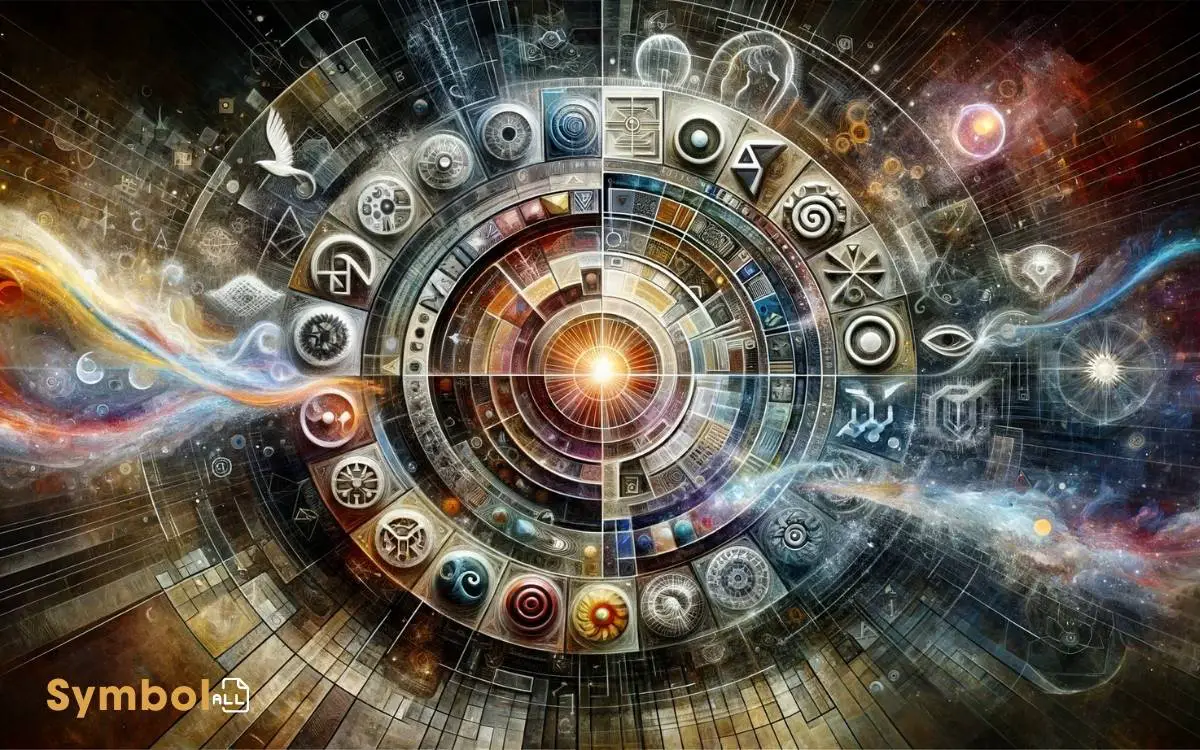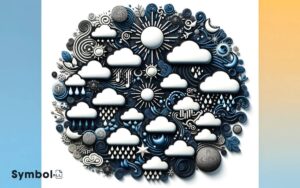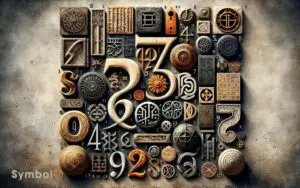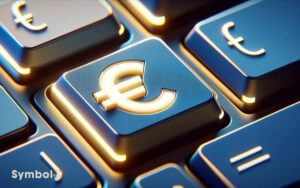Symbols and Archetypes Gain Meaning Through the Use of?
You’re part of a vast tapestry where symbols and archetypes shape your views, beliefs, and connections. These markers, like the cross or crescent moon, gain depth through shared yet diverse human experiences.
They’re not static; their meanings evolve with cultural shifts, reflecting our collective journey. Artists and filmmakers weave these into works, making ancient myths relevant today, bridging gaps between us.
From religious rituals to online memes, symbols and archetypes serve as bridges, conveying deep collective understandings.
Exploring their evolving interpretations offers insight into how you connect with the world’s rich cultural heritage, hinting at undiscovered layers of meaning in your journey.

Key Takeaways
Historical Evolution
Throughout history, cultures around the world have developed and transformed symbols and archetypes, embedding them with meanings that resonate across time and space.
You’ve seen how symbols like the cross or the crescent moon carry profound meanings within different communities, evolving based on historical events, societal changes, and technological advancements.
This dynamic nature of symbols and archetypes showcases humanity’s ability to adapt and reinterpret foundational elements of culture. It’s a testament to the shared yet diverse human experience.
By examining these shifts, you’re not just learning about symbols; you’re uncovering the rich tapestry of human history and the interconnectedness of our stories.
This journey through time reveals how symbols serve as markers of identity, belief, and the human condition, constantly reshaped by the hands of time.
Cultural Significance
Humanity’s relationship with symbols and archetypes reveals deep cultural significances that transcend mere artistic expression, acting as a mirror to society’s values, fears, and aspirations across various cultures.
You’ll find that these symbols serve as a universal language, bridging gaps between disparate communities. They encapsulate the essence of human experience, weaving narratives that resonate on a global scale while retaining unique cultural identities. Their power lies in their ability to convey complex ideas and emotions without the need for translation, fostering connection and understanding across linguistic and cultural barriers. From ancient cave paintings to modern iconography, these symbols used in stories explained profound truths about human nature, triumphs, and struggles. They serve as timeless vessels of meaning, ensuring that the lessons and values of one generation are passed seamlessly to the next.
Through your exploration of different cultures, you’ll notice how certain symbols carry a multitude of meanings, shaped by historical, social, and environmental contexts. They’re not static; their significance evolves as societies change.
This dynamic interplay between symbols and culture underscores the rich tapestry of human heritage, offering you insights into the collective psyche of humanity and the intricate web of connections that bind us all.
Artistic Expression
In exploring artistic expression, you’ll uncover how artists harness symbols and archetypes to communicate complex ideas and emotions that resonate across cultures. Through their work, they tap into a universal language, bridging gaps between diverse groups.
Whether it’s a painting, sculpture, or performance, each piece serves as a mirror reflecting the human condition. You’ll find that artists often draw from a rich tapestry of cultural symbols, blending them in innovative ways that challenge and expand our understanding.
This cross-cultural, ethnographic approach reveals the fluidity of meaning in symbols, showing how they evolve over time and space.
As you delve deeper, you’ll appreciate how artistic expression transcends mere aesthetics, becoming a powerful tool for dialogue and connection in our increasingly globalized world.
Religious Symbolism
Exploring religious symbolism offers a profound insight into how faiths across the globe use powerful icons and narratives to encapsulate their core beliefs and values.
These symbols serve as bridges, connecting the physical to the metaphysical, the individual to the collective.
| Symbol | Religion | Meaning |
|---|---|---|
| Cross | Christianity | Sacrifice, love, and atonement |
| Crescent Moon | Islam | Progress, enlightenment, and growth |
| Lotus Flower | Buddhism | Purity, enlightenment, and rebirth |
| Star of David | Judaism | Interconnection of the divine with the earth |
You’ll find that these symbols aren’t merely decorative. They’re deeply embedded in the rituals, literature, and artifacts of these faiths, providing a tangible representation of intangible beliefs.
They reveal how humans across cultures strive to understand the divine, the universe, and their place within it.
Psychological Impact
Delving into the psychological impact, you’ll discover how these symbols transcend cultural boundaries, shaping individual and collective identities.
This phenomenon isn’t just a byproduct of human nature but a testament to our shared need for understanding and connection.
Here’s how:
- Emotional Resonance: Symbols stir emotions, uniting or dividing us through shared or conflicting values.
- Cognitive Anchors: They serve as mental shortcuts, helping you navigate complex ideas quickly and efficiently.
- Identity Formation: Through symbols, you find and express your place within your community, adopting its values as your own.
- Behavioral Influence: They can motivate actions, guiding you towards or away from certain beliefs and practices.
This cross-cultural, ethnographic analysis reveals that symbols act as bridges, not just between individuals but across the vast expanse of humanity itself.
Myth and Legend
Building on the understanding of symbols’ psychological impact, let’s examine how myths and legends serve as powerful narratives that shape our perceptions of reality across cultures.
These stories, rich with symbolic meaning, aren’t just ancient tales but are alive, influencing how you see the world today.
Across continents, from the Greek pantheon to Native American folklore, myths carry collective wisdom, encapsulating the fears, hopes, and values of a culture. They’re not random; they’re the distilled essence of human experience, tailored to guide, teach, and sometimes warn.
As you delve into these stories, you’ll notice they’re a mirror, reflecting the universal concerns of humanity while dressed in the unique garb of each culture.
This exploration offers you a deeper understanding of not just the world’s heritage but also of the common threads that connect us all.
Archetypal Characters
As we navigate the realm of myth and legend, it’s crucial to recognize the role of archetypal characters, universal figures that transcend cultural boundaries and resonate deeply within our collective psyche.
These characters embody fundamental human experiences, serving as a bridge between the personal and the universal.
- The Hero: Embarks on a journey, overcoming challenges and embodying courage.
- The Mentor: Provides wisdom, guidance, and support to the hero.
- The Shadow: Represents our darker selves or adversaries the hero must confront.
- The Trickster: Brings change, often through mischief or cunning, challenging the status quo.
Understanding these archetypes enriches your comprehension of narratives across cultures, revealing the shared human experience embedded within our diverse stories and traditions.
Dreams and Visions
Dreams and visions often serve as profound, universal channels through which the subconscious communicates with our conscious understanding, cutting across cultural divides to reveal deeper truths about our shared human condition.
In every corner of the world, dreams are seen as gateways to understanding oneself and the universe. They embody symbols and archetypes that, despite their diverse appearances, share common meanings across cultures.
You’ll find that dreams can guide, warn, or inspire by tapping into a collective unconscious, a concept that suggests there are shared symbols and themes universally recognized.
Through dreams, you’re not just exploring personal insights but are also connecting with a broader, cross-cultural narrative that has shaped human understanding and spirituality for generations.
This exploration offers a unique lens into how symbols and archetypes gain meaning beyond the surface level.
Modern Media Influence
You’ve observed how symbols and archetypes morph across cultures, but modern media, especially films, take this transformation to new heights.
By presenting archetypal stories in visually dynamic ways, filmmakers across the globe influence your understanding and interpretation of these ancient patterns.
This cross-cultural, ethnographic lens on media allows you to see the evolution of symbol interpretations as they’re adapted for contemporary audiences.
Evolving Symbol Interpretations
Modern media significantly shapes our understanding of traditional symbols, often imbuing them with new meanings that resonate across different cultures.
As you navigate through various platforms, you’ll notice how:
- Visuals transcend language barriers, allowing symbols to adopt universal meanings that weren’t initially associated with them.
- Cultural appropriation sometimes leads to misinterpretations, yet also promotes dialogue about original meanings and respects.
- Social media trends can rapidly change the perception of symbols, making them relevant to contemporary issues and audiences.
- Globalization merges Eastern and Western symbol interpretations, creating a rich tapestry of meanings that encourage a deeper global connection.
These evolving interpretations highlight the fluid nature of symbols in our interconnected world, urging you to explore and understand the layers of meanings they carry.
Archetypal Representation in Film
Films often serve as a mirror, reflecting the complex web of archetypes that resonate deeply across cultures, shaping our collective understanding of heroism, villainy, and the journey in between.
You’ll find that regardless of the film’s origin, these archetypal characters and narratives transcend cultural and linguistic barriers, speaking to universal human experiences.
Directors and screenwriters weave these timeless symbols into their narratives, making ancient myths and legends accessible and relevant to modern audiences.
Through cinema, you’re invited to explore the depths of your own psyche, identifying with characters that embody the fundamental aspects of human nature.
This cross-cultural, ethnographic approach to storytelling in film not only entertains but also educates, offering insights into the shared human condition. It’s a testament to the power of visual storytelling in bridging diverse worlds.
Personal Identity Formation
In exploring the intricate weave of symbols and archetypes, we find they play a crucial role in the formation of personal identity across various cultures.
These elements aren’t just visual or literary motifs; they’re the mirrors reflecting the multifaceted aspects of who you’re and where you belong.
Here’s how:
- Cultural Heritage: They anchor you to your roots, providing a sense of belonging and continuity.
- Personal Values: Through them, you internalize the virtues and principles esteemed by your community.
- Psychological Development: They guide you through life’s stages, symbolizing growth and transformation.
- Social Identity: They demarcate the boundaries of in-groups and out-groups, shaping your social interactions and affiliations.
This cross-cultural, ethnographic analysis reveals symbols and archetypes as the scaffolding upon which personal identities are constructed and understood.
Collective Consciousness Connection
Deeply embedded within every culture’s fabric, symbols and archetypes forge a bridge to collective consciousness, shaping how communities perceive themselves and the world around them.
Across diverse cultures, symbols like the dragon in East Asia or the eagle in North America aren’t just emblems; they’re a language without words, conveying values, fears, and aspirations common to people within those cultures.
They’re how societies express their collective identity, history, and even future ambitions.
This isn’t just about shared beliefs; it’s about a shared understanding that transcends individual experiences. You’re tapping into a rich tapestry of human connection and heritage each time you engage with these symbols.
It’s a powerful reminder that, despite our differences, there’s a universal language of symbols and archetypes connecting us all.
Conclusion
You’ve journeyed through the intricate web of symbols and archetypes, witnessing their evolution across the sands of time.
These motifs serve as the cultural threads weaving humanity’s collective tapestry, embedding themselves in art, religion, and dreams alike.
In the modern era, they shape identities and echo in the digital halls of media, reminding us of our shared subconscious.
Like stars in a vast sky, they guide our narratives, connecting us across the invisible bridges of collective consciousness, lighting the path to understanding our multifaceted existence.






